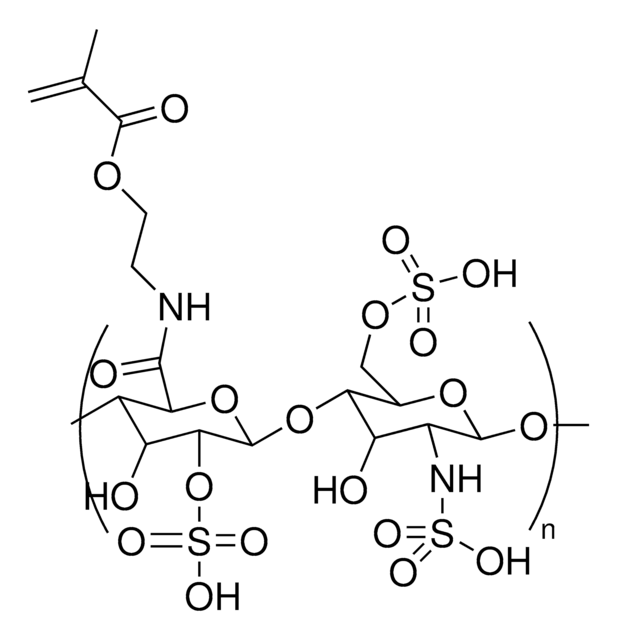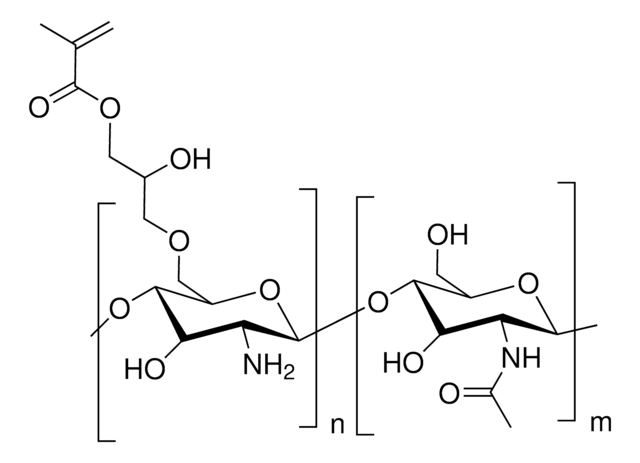925632
Poly(ethylene glycol)-block-Poly(2-methacryloyloxyethyl phosphorylcholine)
PEG average Mn 5000, PMPC Mn 21,000
Synonym(e):
PEG-b-PMPC, PEG-PMPC
Anmeldenzur Ansicht organisationsspezifischer und vertraglich vereinbarter Preise
Alle Fotos(1)
About This Item
Lineare Formel:
CH3(C2H4O)nC6H7O2N(C11H22O6NP)
UNSPSC-Code:
12352112
NACRES:
NA.23
Empfohlene Produkte
Verwandte Kategorien
Anwendung
PEG-b-PMPC is a biocompatible, non-fouling block copolymer composed of a neutral PEG block and a zwitterionic poly(2-methacryloyloxyethyl phosphorylcholine) (PMPC) block.
Poly (2-Methacryloyloxyethyl phosphorylcholine) (PMPC) is a methacrylate based polymer with a zwitterionic phosphorylcholine moiety on the side chain. The phosphorylcholine moiety is very similar to the head group of phospholipids in cell membranes. Due to this unique structure, PMPC showed excellent resistance to nonspecific protein adsorption, cell adhesion, and blood coagulation, as well as cell membrane penetration and underwater lubrication.
PMPC has been widely exploited in a diverse range of applications including
Poly (2-Methacryloyloxyethyl phosphorylcholine) (PMPC) is a methacrylate based polymer with a zwitterionic phosphorylcholine moiety on the side chain. The phosphorylcholine moiety is very similar to the head group of phospholipids in cell membranes. Due to this unique structure, PMPC showed excellent resistance to nonspecific protein adsorption, cell adhesion, and blood coagulation, as well as cell membrane penetration and underwater lubrication.
PMPC has been widely exploited in a diverse range of applications including
- antifouling materials for water treatment
- bioengineering
- nanomedicine
Lagerklassenschlüssel
11 - Combustible Solids
WGK
WGK 3
Flammpunkt (°F)
Not applicable
Flammpunkt (°C)
Not applicable
Analysenzertifikate (COA)
Suchen Sie nach Analysenzertifikate (COA), indem Sie die Lot-/Chargennummer des Produkts eingeben. Lot- und Chargennummern sind auf dem Produktetikett hinter den Wörtern ‘Lot’ oder ‘Batch’ (Lot oder Charge) zu finden.
Besitzen Sie dieses Produkt bereits?
In der Dokumentenbibliothek finden Sie die Dokumentation zu den Produkten, die Sie kürzlich erworben haben.
Andrew Lewis et al.
Bioconjugate chemistry, 19(11), 2144-2155 (2008-11-01)
The water-soluble, biocompatible polymer poly(2-methacryloyloxyethyl phosphorylcholine) (PMPC) was evaluated for protein conjugation. PMPC is a zwitterionic polymer that is able to form a more compact conformation in aqueous solution than poly(ethylene glycol) (PEG). While a terminally functionalized N-hydroxysuccinimide derivative of
An introduction to zwitterionic polymer behavior and applications in solution and at surfaces.
Blackman L D, et al.
Chemical Society Reviews, 48, 757-757 (2019)
Andrew Lewis et al.
Bioconjugate chemistry, 19(11), 2144-2155 (2008-11-01)
The water-soluble, biocompatible polymer poly(2-methacryloyloxyethyl phosphorylcholine) (PMPC) was evaluated for protein conjugation. PMPC is a zwitterionic polymer that is able to form a more compact conformation in aqueous solution than poly(ethylene glycol) (PEG). While a terminally functionalized N-hydroxysuccinimide derivative of
Critical update on 2-methacryloyloxyethyl phosphorylcholine (MPC) polymer science.
Goda T, et al.
Journal of Applied Polymer Science, 41766-41766 (2015)
Unser Team von Wissenschaftlern verfügt über Erfahrung in allen Forschungsbereichen einschließlich Life Science, Materialwissenschaften, chemischer Synthese, Chromatographie, Analytik und vielen mehr..
Setzen Sie sich mit dem technischen Dienst in Verbindung.








